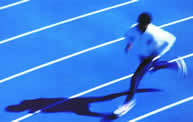12th Edition of the
Paraolympics in
Athens
by Rodolfo Cattani
Some believe that competing disabled athletes are not able to
obtain significant results, but that is not at all
true.
Disabled athletes from all over the world will meet in 2004 in
Athens, symbol city of sport, in order to compete in about 20 different
sport disciplines. It is an emblematic event, a testimony to the will to
compete, to persevere and surpass oneself in a sporting spirit.
There
is a need for the sport even among persons with disabilities. This will
again be demonstrated next September, when in Athens' Olympic stadium, a
torchbearer with a disability will light the sacred flame for the 2004
Paraolympics.
Cradle of the Olympics and of the sporting ideal which
unites nations in a pure spirit of competition, Greece will welcome this
year in its inimitable environmental, historical and cultural scenario,
the 28th Olympic Games and the 12th edition of the Paraolympics reserved
for disabled athletes. The term Paraolympics refers to the games in which
only disabled athletes participate with the same spirit and enthusiasm as
those who are not disabled, but with whom they cannot compete directly
because of their limitations. Paraolympics are just like the Olympic Games
and the International Olympic Committee has decided that they must take
place in the same country as the Olympic Games.
The Paraolympics are a
true sporting event and not only a simple demonstration of competitive
capabilities of persons with disabilities.
The organization of the
Paraolympics is not much less important than the Olympic Games: the
majority of the 220 hotels in Athens are booked to host, from the 17th to
the 28th of September, nearly 4,000 disabled athletes, coming from 130
countries and constituting 2,000 official teams. This is not counting a
number of 1,000 technicians and 15,000 volunteers. More than 300 media
representatives from newspapers, radio and television, have already been
accredited to broadcast the event all over the world. For the first time
in the history of the Paraolympics, the athletes will not have to pay any
participation fee so as to encourage as much as possible the presence of
athletes and eliminate any form of discrimination between Olympic and
Paraolympic athletes.
Another first in Athens is the fact that the
organization of both events will be entrusted to the same staff.
The
first sporting events for disabled athletes took place in 1948 in Stoke
Mandeville, UK. It was a competition involving athletes in wheelchairs,
which took place on the same day and at the same time as the opening
ceremony of the Olympic Games taking place that year in London. Four years
later another competition between disabled athletes was organized in
Holland, giving birth to the Paraolympic movement.
However, only later
disabled athletes  succeeded in having organized a specific sporting event Olympic
style, which occurred immediately after the 17th Rome Olympics in 1960. A
number of 400 athletes from 23 countries participated in 8 sporting
disciplines. From then on, the Paraolympics have always been organized
every four years and in the same year as the Olympics. In 1976, after the
Toronto Games, the first winter Paraolympics took place in Switzerland
with flattering results.
succeeded in having organized a specific sporting event Olympic
style, which occurred immediately after the 17th Rome Olympics in 1960. A
number of 400 athletes from 23 countries participated in 8 sporting
disciplines. From then on, the Paraolympics have always been organized
every four years and in the same year as the Olympics. In 1976, after the
Toronto Games, the first winter Paraolympics took place in Switzerland
with flattering results.
In Seoul, in 1988, the Paraolympics obtained
another important success because it was the first time that they took
place in the same venue as the Olympics. This practice became the rule for
all successive editions except in 1980, when the Soviet Union refused to
organize the Paraolympics maintaining that there were no persons with
disabilities in the territory.
Some may believe that competing disabled
athletes in the Paraolympics are not able to obtain significant results,
but that is not at all true. As a matter of fact, their athletic
performances are of high level and their records are no doubt comparable
to those of Olympians.
Canadian Donovan Bailey holds the world record
for the 100 meters in 8' 84", and Nigerian Ajibola Adoye, an arm amputee,
has covered the same distance in 10' 72". In four categories of
weightlifting the Paraolympic record winners are superior to the Olympic
winners by 12 kilograms.
Of course, one must keep in mind that persons
with disabilities have limits because of which they cannot compete in all
sports, for example judo is practiced only by blind athletes.
PARAOLYMPICS IN HISTORY
|
Year |
City |
Participants |
Countries |
|
1960 |
Rome (Italy) |
400 |
23 |
|
1964 |
Tokyo (Japan) |
390 |
22 |
|
1968 |
Tel Aviv (Israel) |
750 |
29 |
|
1972 |
Heidelberg (Germany) |
1,000 |
44 |
|
1976 |
Toronto (Canada) |
1,600 |
42 |
|
1980 |
Arnhem (Holland) |
2,500 |
42 |
|
1984 |
Stoke Mandeville (United Kingdom) New York (USA) |
4,080 |
42 |
|
1988 |
Seoul (Korea) |
3,053 |
61 |
|
1992 |
Barcelona (Spain) |
3,020 |
82 |
|
1996 |
Atlanta (USA) |
3,195 |
103 |
|
200 |
Sydney (Australia) |
3,843 |
123 |
|
SPORTING DISCIPLINES AT THE PARAOLYMPICS Archery |


